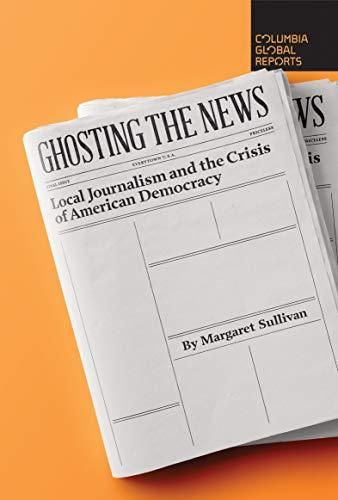Former Washington Post media columnist Margaret Sullivan details a dangerous trend in America and worldwide: The loss of local newspapers on a grand scale.

No News Is Bad News
Former Washington Post media columnist Margaret Sullivan outlines a crisis in American journalism: Since 2010, US newspapers have cut nearly half their staffs, and thousands of papers have closed. When local reporting disappears, she finds, government and corporate corruption rises.
Sullivan insists convincingly that people depend on local news to stay politically informed and engaged. She regards the death of regional papers – bulwarks of democracy – as a profound crisis. Sullivan takes a melancholy, warning tone, but her references to alternative local news sources may encourage you.
Margaret Sullivan was the first woman to become Public Editor of The New York Times. The Washington Post placed this vivid book among its 50 Notable Works of Nonfiction in 2020 and NPR named it among the best books of 2020.
2,000 American Newspapers
Between 2008 and 2017, American newsrooms cut 45% of their staff. Since 2004, more than 2,000 US newspapers have gone out of business, and others no longer have the financing to perform their traditional, invaluable function of holding local people, politicians, businesses and institutions accountable.
I’m not here to address the politicized fake news problem or the actual disinformation problem. This book is about the real-news problem.Margaret Sullivan
At that time New York Times editor Dean Baquet acknowledged that most local newspapers will go out of business in the near future, except for those rich people bought and own. Substantial regions of the United States now lack a decent local paper or news outlet. Thus, many people don’t know what’s going on in their own area. Yet most Americans think local news outlets are in good economic shape.
The 2008 financial crisis shattered the newspaper industry. Print advertising, its main revenue source, disappeared. Paid circulation plummeted. On the business side and the journalistic side, newspapers lacked a long-term “digital strategy,” because for a long time digital advertising had been insignificant and access to most websites had been free.
Monopolies
Having vanquished its local competitor in the early 1980s, The Buffalo News made money hand over fist, as did other newspapers that were monopolies in their markets.
Then came 2008. It would turn out to be a terrible year for newspapers, followed by many more terrible years in a row.Margaret Sullivan
Papers could charge for classified advertising in part because people lacked worthy alternative outlets. But, Sullivan relates, in San Francisco in the mid-1990s, Craig Newmark started an online newsletter in which people could post items for sale or offer services for hire. By 2006, Craigslist was among the top 10 most-viewed websites in the US, devastating newspaper classifieds.
An even more profound change was coming from two dominant technology platforms, Google and Facebook, who have been able to attract the vast portion of digital advertising.Margaret Sullivan
Later, Google and Facebook grew to absorb more than half of all digital advertising in the United States.
Innovative Approaches
In East Lansing, Michigan, which lacks any local coverage, Michigan State University teacher Alice Dreger trained citizen journalists. They created a website, East Lansing Info (ELI), which covered important issues, such the city’s massive pension debt. Local journalists now run ELI effectively on a tiny annual budget.
Digital sites, it turns out, present many of the same problems as ones exhibited by newspapers. How do you capture advertising revenue, convince users to pay for your service, free yourself from the fickleness and meddling of owners and donors?Margaret Sullivan
Showcasing another innovative solution, Community Impact of Pflugerville, Texas, prints 34 different newspapers in four states, and mails the publications free to residents. Highly specific, targeted advertising finances the operation.
A Global Problem
In Italy, newspaper print circulation has fallen more than 50%. Nearly a third of Brazil’s population lives in a news desert. In 2017, Australia’s two major “legacy newspapers” faced significant staff reductions. Anywhere in the world, when local newspapers disappear or get downsized to ghosts of themselves, the result is an increase in public corruption, divisions between citizens and a lack of public engagement.
New Funding Models
President Donald Trump claimed that journalists are enemies of the American people and many voters agree with him. Surprisingly then, the public holds positive views about local news.
Funding nonprofit journalism can be a constant, gnawing problem. Margaret Sullivan
ProPublica and Austin’s Texas Tribune created an Austin-based investigative team to focus on “government accountability coverage.” Arnold Ventures in Houston made a donation to finance the project. San Francisco billionaires, Herbert and Marion Sandler, funded ProPublica in 2007. And the nonprofit Texas Tribune, founded in 2009, has become proficient in raising funds.
While some local news organizations must focus on digital editions and online subscriptions to survive, nonprofits that seek donations may be in a stronger position. However, these nonprofit news organizations must live with a nonstop fundraising challenge, and they can’t match the work of a thriving big-city newspaper.
Haves and Have-Nots
Major institutions such as The New York Times have the leverage and credibility to garner digital subscribers. Yet, most local newspapers remain among the have-nots.
Home delivery of a printed paper certainly isn’t the most dependable measure of a news organization’s value, but when it withers away, something important is lost. Margaret Sullivan
Despite publishing work worthy of Pulitzer Prizes, they face economic risk. Midsize American cities, such Pittsburgh, Cleveland and Detroit, no longer have a printed newspaper that is delivered to people’s homes.
Social Unity
The demise of local newspapers leaves poor, vulnerable and marginalized people without a venue for airing their issues and concerns.Society needs local reporters to bring attention to local governments and civic issues, such as poverty.This coverage keeps public officials accountable, and informs local people about issues that affect their daily lives.
I am convinced that those who care about good journalism have to do whatever is possible to make things better – more than is being done now. Margaret Sullivan
Local papers support unity and encourage political engagement. Unfortunately, they seem likely to continue to vanish – and at a quickening pace, especially in rural areas. Politics will become more divisive. Corruption at all levels will thrive. And the ties that bind communities will fray.
A Grim Prognosis
Margaret Sullivan notes that she writes for the most secure possible news outlet – because a billionaire owns it. That billionaire is Amazon’s Jeff Bezos, who keeps The Washington Post thriving; he can afford to. Sullivan contrasts her situation with desperate local reporters around America and the world. Most recognize that their outlets will not survive and that, increasingly, news monoliths such as the Sinclair Broadcast Group will dominate rural American news with no one to hold it to account for the merit and truth of its reporting. Sullivan is a superb, concise writer, not given to hand-wringing, but she has little good news to offer. Concerned citizens will heed her message.
Margaret Sullivan also wrote Newsroom Confidential: Lessons (and Worries) from an Ink-Stained Life.









